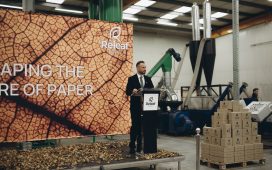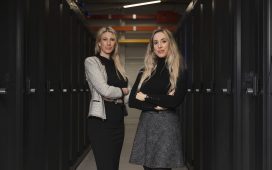During the opening day of the 2023 NRF Show, at New York’s Javits Center, Progressive Grocer was lucky enough to get to speak with Rom Kosla, EVP and CIO of Ahold Delhaize USA, who graciously took a few minutes’ break from a workshop where he was exchanging ideas with his counterparts at other companies, to speak with the publication about technology currently being implemented at his organization, and what lies ahead in the retail technology realm. The conversation, edited for length and clarity, is as follows.
Progressive Grocer: So, what can you tell me about some of the technology that Ahold Delhaize is currently working on deploying? Can you tell us about what may be in the pipeline?
Rom Kosla: Automation is big. Either data automation as well as potentially certain things that can cross or relieve some labor pressure. We’re implementing a frozen distribution center where lots of labor do not want to work in cold stores, because they’re -20, -30 degrees. We’re building two automation facilities in the East Coast, and we’re partnering with businesses to put [them] together. I got to visit one of them. It’s large towers with lots of robotics that are breaking down the products, and in some cases storing [items] in these large freezers.
Those things are actually a big part of our future vision, because we do struggle with labor shortfalls, but we also know that our ability to better manage inventory is important, just to make sure what’s in stock and what we can deliver to our stores. So, at the supply side, that’s a big part of what we’re doing. We’ve implemented some modern warehouse solution systems. Part of it is when we brought in some of our distribution centers, we had an opportunity to greenfield this and build our own. We implemented Manhattan [Associates’ solution] for our Manchester, Conn., location. And what that gave us is a lot more detailed understanding of how we’re keeping track of all our inventory. So, everything from cross-stocking, everything from how we’re actually maintaining our supply for particular products that are scarce, but we need to determine where do we want to ship that to which stores.
Overall, lots of things are helping our business understand our inventory availability, and then also our ability to manage our resources accordingly. At the retail front, a lot of the things that we’re doing on technology in some cases depends on our brands. Our brands are unique, but [for] some of our brands, we are implementing or expanding out our self-checkout. We have camera analytics that are being deployed [from Everseen.] It allows us to reduce shrink. In essence, we can deploy more of our self-checkout, and the system will start to recognize different products and what’s happening so that we can understand what’s actually happening at the checkout. It’s piloting [at] a few stores, and we’re deploying that for some of the brands that I think have found the business case.
For us, technology represents opportunities. One of the things that we’re also doing is upgrading our Marty robots, [with] the googly eyes. We’re looking at ways for Marty to scan the shelves. Right now, Marty’s primary role is more safety, so if there’s spills, to manage that. But Marty also has cameras and the ability to actually start to scan through the different parts of the aisles and determine out-of-stock potentially. Again, these are all opportunities we haven’t fully baked in yet, but we had the investments already with robotics. In fact, Ahold Delhaize in the U.S. already started doing that a few years ago. So, it’s now Marty 2.0, we call it.
And we’re going to be implementing more interesting technology to help with – I guess the term might be more like “digital twin” – understanding exactly what’s happening inside the store, what are the analytics that could help gather more of the digital planogram views that, are we in compliance, do we have the right pricing, do we have out-of-stocks, can we be more interactive or more maybe prescriptive about ordering specific products? Those are a little bit more futuristic, but the platform and foundation of that exist today.
PG: What is your company doing in terms of e-commerce solutions or honing your e-commerce operations?
RK: For us, e-commerce is growing significantly during COVID, right? And then post-COVID, it’s actually continued to grow. We’ve grown about 21% up to Q3 this year. Volume has been still fairly steady. What that basically means for us as a company is that we’re continuing to invest in it. Our e-commerce solution is actually in-house. Peapod Digital Labs, originally Peapod, was purchased by Ahold a couple decades ago. The decision post-merger [of Ahold and Delhaize] was to continue to really innovate on this capability.
Now, the good news is that solution initially was able to handle the volume, but we know now that the volume is growing continuously so we’re migrating it from a kind of our own internal data center into the cloud. Now we have the ability to really scale. Elastic computing is a part of our strategy. If we see a seasonal demand, we’ll manage that demand, because we’ll actually have the computing power to handle that. That’s actually an interesting thing. I can’t share anything by Q4, but I would say that during spikes in holiday seasons prior to our moving to the cloud, we’d always have production issues. We’d have some level of like, “Oh my gosh, demand is higher than we can handle.” It was the quietest Q4, and the volume was one of the highest that we’ve seen ever, post-COVID.
PG: For the retail sector in general, what do you think are going to be the major technological challenges or issues that retailers are going to have to deal with and to try to find solutions to?
RK: I’ve only been in retail for two years; I came mostly from CPG. But the volume of data that we manage – about 100,000 SKUs – and the number of stores, the number of customers that we’re engaging with on a daily basis, the amount of data that we’re processing, is unbelievable.
Now, from a retail challenge perspective, it’s how do we personalize that? Personalization and making sure that our customers see value in the engagement with our brands, but also that we are a partner in their day-to-day lives. That’s an important part. We need to hone our skills better on just how do we make use of the data, and also help it to grow our future view of what do we want to do with our engagement with our suppliers. That also helps us understand how do we forecast better. That’s the biggest topic we’re seeing today at the workshop is just how much data that’s there, and how can we predictively use that data on a more accurate basis.









